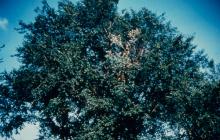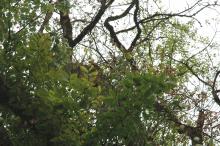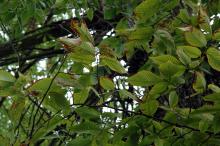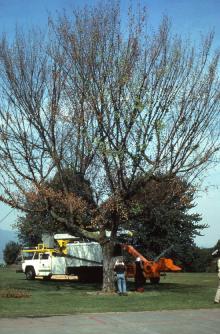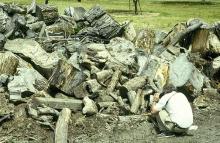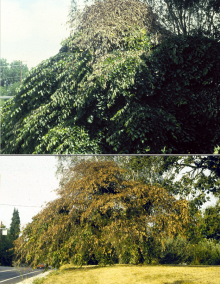Cause Ophiostoma ulmi (formerly Ceratocystis ulmi) and O. novo-ulmi, fungi with many subgroups. The first of two North American epidemics began in the 1920s with the introduction of a relatively non-aggressive subgroup, which reduced the native elm population. A second, more destructive epidemic began in the 1940s with the introduction of a more aggressive subgroup, which has been found in Oregon.
Diseased trees were first found in the Pacific Northwest in Boise, ID in 1968. The next reports were from Ontario in 1973 and La Grande and Union, OR in 1974. A single tree was found in Portland in 1976 and was removed promptly. No other trees were identified until a new outbreak in Eugene and Portland in 1986. Since then, additional Oregon locations include Hillsboro in 1987, Salem in 1988, Corvallis in 1995, Heppner in 1999, Pendleton in 2000, and Medford in 2006. Most of the diseased trees have been from the Portland area. The disease continued its spread with reports from Moscow and Weiser, ID and Spokane, WA in 1990 and Tacoma and Bellevue, WA in 1994. The disease has continued to spread into the greater Seattle area. As of 2008 it has not been found in British Columbia but it was confirmed Utah in 2019.
The disease is spread by several bark beetles, the most important of which is the smaller European elm bark beetle (Scolytus multistriatus). These bark beetles breed in diseased trees but feed on healthy ones.
The fungus produces spores (Graphium type) in beetle galleries beneath the bark of dead or dying wood. Spores on or in the beetle's body can be carried to and infect healthy trees during feeding. Beetles overwinter as larvae under the bark of unhealthy or injured trees or cut logs. In spring, larvae complete their growth, pupate, and change into adult beetles. The adult flies a short distance and feeds on the bark of small branches of living elms (beetles are active from mid-May to early October). After feeding in the canopy of healthy trees, adults seek breeding sites under the bark of dead or weakened trees or logs. They bore through the bark and into the cambium area to lay eggs.
Spores in the feeding site grow into the tree's vascular system. The mycelium continues to invade the vascular system, forming new spores (Sporothrix type) and toxins that clog the xylem and kill living cells. The result is a wilting and dying of the tree distal to the areas the fungus invaded. Trees are most susceptible in spring, during shoot elongation. The entire tree may die in a few weeks or take a year depending on how rapidly the fungus progresses down to the roots.
When elms grow within 40 ft of each other, their roots often cross and form natural grafts. The fungus in the vascular system of one tree can invade the adjoining tree through the graft.
Many elm species are highly susceptible to the disease including American, Belgian, English, red, rock, September, European white, and winged elms. Intermediately susceptible are cedar, European field, and wych elms. Chinese, Japanese, and Siberian elms have resistance. Oregon continues to quarantine all Ulmus, Zelkova and Planera spp., which must be certified free of Dutch elm disease (and elm yellows) before entering the state.
Symptoms Early symptoms are wilting leaves and sparse foliage, first on single limbs but later the entire tree may be affected. Yellowing and premature defoliation follow. Symptoms may show only a few days after infection has occurred. If infection is high in the tree and late in the year, disease progress may be slow. If main limbs are infected through lower branches in spring, progress may be rapid, and the tree can wilt and die in a short time. These symptoms may be confused with other vascular wilt diseases or summer heat stress.
Infected sapwood shows brown streaking especially in its current-season growth. A cross-section often shows either a broken or continuous brown ring in outer growth rings.
Sampling Select twigs about 6 inches long from recently killed branches or small pieces of living trunk that show a dark discoloration or brown streaking of the wood just below the bark. Trunk samples near the root flares have been used in Portland, OR to identify infected trees. These trees tested negative for DED in upper branches and this might be due to root graft transmission. Decayed bark, badly rotted wood, or dry, dead twigs are of no value for identification.
Cultural control Many methods must be integrated to manage this disease. Prompt sanitation is the primary way to prevent disease.
- The best approach for susceptible trees is to rapidly detect and remove diseased trees. Communities without the disease or with low disease incidence should map all susceptible trees and regularly scout them for symptoms of Dutch elm disease.
- Trees with 25% or more of the crown showing symptoms cannot be saved. Trees infected via root grafts cannot be saved, either. Detailed pruning may save trees at the earliest stage of the disease. Limbs must be cut well below (several feet) discolored cambial tissue soon after a positive diagnosis.
- Remove and burn all dead wood and branches before beetles emerge in spring. This includes branches weakened by storm damage, drought, etc. Pruning is best done during the dormant season. Remove the bark if branches cannot be disposed of quickly because the bark beetles can complete their life cycle only in logs with bark intact. Even small patches are enough for the beetles to complete their life cycle. Do not save branches or logs for firewood unless bark is completely removed.
- Protect trees within 25 to 50 ft by severing root grafts with a mechanical trencher. Do this before removing adjacent, diseased trees.
- Grind stumps of removed trees, or remove the bark below the soil surface.
- Plant resistant elm species or hybrids including American Liberty clones, 'Cathedral', 'Delaware', 'Frontier', 'Homestead', 'Independence', 'New Harmony', 'New Horizon', 'Patriot', 'Pioneer', 'Regal', 'Sapporo Autumn Gold', and 'Valley Forge'. Many of these are also reported to be resistant to elm leaf beetle.
- Maintain tree vigor and health through proper management during the growing season. This may include watering or protection from nearby construction.
- Avoid developing gardens (rototilling, etc.) directly under trees.
Chemical control Use only when integrated with cultural controls. Trunk injections are least effective and must be repeated over the life of the tree (possibly every other year). Injections are recommended only for extremely high value trees. Preventive treatments are much more effective than therapeutic treatments. Hole placement is critical for uptake and complete tree coverage. Generally, make small, shallow holes close to the ground on the root flares. Rates are based on trunk diameter. See labels for details. Wounding associated with regular fungicide injection does not increase the likelihood of internal decay of trees.
- Alamo at 6 to 10 ml per injection site for each inch of tree diameter at breast height (DBH). There is concern about possible phytotoxicity to the cambium of injected trees. Group 3 fungicide.
- Arbotect 20-S at 1 to 2 fl oz/5 inches trunk diameter annually or at 12 fl oz/6 gal water/5 inches trunk diameter every 3 years but only if trees are greater than 10 inches in diameter. This active ingredient has been used successfully for many years both as a preventative and therapeutically. 0-hr reentry.
- Fungisol has had variable results, which may have been to due to rate differences. Washington and Idaho only. 0-hr reentry.
- Phyton 27 is not recommended because it is difficult to get into the trees, is phytotoxic to the cambium around injection sites and has not shown significant control.
- Propizol is registered for trunk injection, see label for details. Group 3 fungicide. 24-hr reentry.
- Shepherd at 5 to 10 ml per injection site for every 3 to 5 inches of tree circumference. Group 3 fungicide.
- Strider is registered for trunk injection, see label for details. Group 3 fungicide. 12-hr reentry.
- Tebuject. Do not inject trees less than 2-inches in diameter or unless trees are suffering from various stresses.
For detecting root grafts:
- Remove infected trees and immediately apply glyphosate (such as Agri Star GlyStar Original) to the cut stump following the procedure outlined on the label. In addition to killing roots and suckers, this will allow you to identify root grafted trees, which may also be infected and need to be removed. Only needed if whole trees have collapsed prior to removal. This application would not be necessary if the disease has not spread into the roots.
Biological control Injecting Verticillium albo-atrum WCS850 into trees has been effective at limiting new infections but must be repeated annually. This treatment will not control infections that arrive through root grafts. There are no commercial formulations.
References Brazee, N.J. and Marra, R.E. 2020. Incidence of Internal Decay in American Elms (Ulmus americana) Under Regular Fungicide Injection to Manage Dutch Elm Disease. Arboriculture and Urban Forestry. 46:1-11.
Lanier, G.N. 1987. Fungicides for Dutch elm disease: Comparative evaluation of commercial products. Journal of Arboriculture 13:189-195.
Scheffer, R.J.; Voeten, J.G.W.F. and Guries, R.P. 2008. Biological control of Dutch elm disease. Plant Disease 92:192-200.

